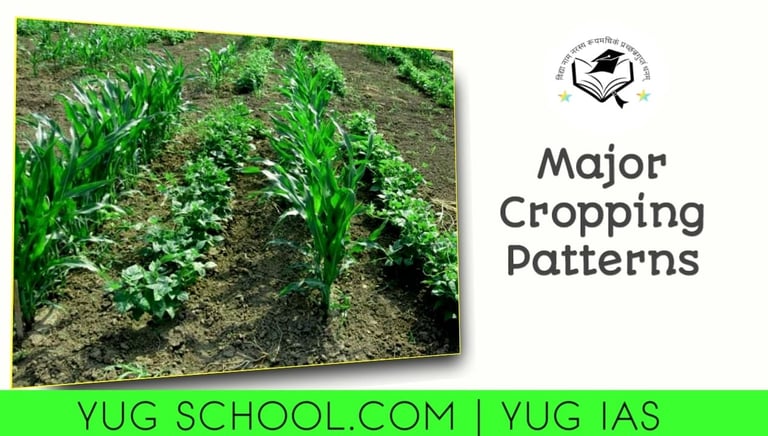Major Cropping Patterns in various parts of the country
These cropping patterns are influenced by various factors like climate, soil fertility, water availability, and market demands
GENERAL STUDIES 3


India's diverse geography leads to a vast array of crops cultivated across different regions. These cropping patterns are influenced by various factors like climate, soil fertility, water availability, and market demands. Here's a glimpse into the major cropping patterns in different parts of India:
North India:
Major crops: Wheat, Rice, Maize (Corn), Barley, Gram
Cropping seasons: Kharif (summer) and Rabi (winter)
Reasoning: The region experiences hot summers and cold winters with moderate rainfall. Wheat and barley are predominantly grown during the rabi season, while rice and maize are cultivated during the kharif season.
Central India:
Major crops: Cotton, Soybean, Wheat, Jowar, Gram
Cropping seasons: Kharif and Rabi
Reasoning: The climate is characterized by hot summers and mild winters with moderate to high rainfall. Cotton, soybean, and jowar are Kharif crops, while wheat and gram are grown during the rabi season.
East India:
Major crops: Rice, Jute, Sugarcane, Pulses, Oilseeds
Cropping seasons: Kharif and Rabi
Reasoning: The region receives abundant rainfall, making it suitable for rice cultivation. Jute, a Kharif crop, is extensively grown in West Bengal. Sugarcane, pulses, and oilseeds are also cultivated in this region.
West India:
Major crops: Cotton, Groundnut, Sugarcane, Wheat, Tobacco
Cropping seasons: Kharif and Rabi
Reasoning: The climate varies across the region, with semi-arid areas in Gujarat and Maharashtra and coastal areas with higher rainfall along the Konkan coast. Cotton, groundnut, and sugarcane are Kharif crops, while wheat is sown during the rabi season. Tobacco is another significant crop in some parts of the region.
South India:
Major crops: Rice, Cotton, Sugarcane, Pulses, Coffee
Cropping seasons: Kharif, Rabi, and Zaid (short season between Kharif and Rabi)
Reasoning: The region experiences a tropical climate with well-distributed rainfall. Rice is the dominant crop throughout the year. Coffee is a major plantation crop grown in the hills of Karnataka and Kerala. Sugarcane and pulses are also cultivated extensively.
It's important to note that these are general trends, and specific cropping patterns can vary within each region depending on local conditions and farmer preferences.
